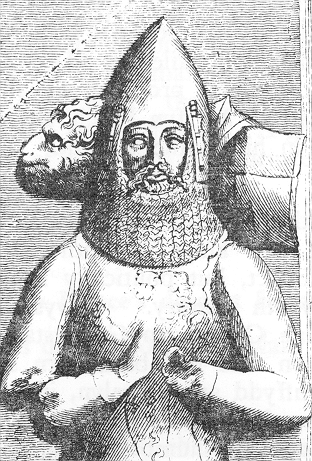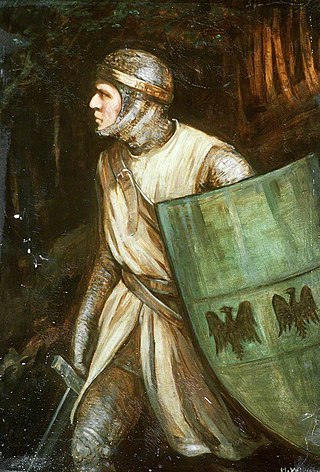
Rhys ap Gruffydd or ap Gruffudd was the ruler of the kingdom of Deheubarth in south Wales from 1155 to 1197. Today, he is commonly known as The Lord Rhys, in Welsh Yr Arglwydd Rhys, although this title may have not been used in his lifetime. He usually used the title "Proprietary Prince of Deheubarth" or "Prince of South Wales", but two documents have been discovered in which he uses the title "Prince of Wales" or "Prince of the Welsh". Rhys was one of the most successful and powerful Welsh princes, and, after the death of Owain Gwynedd of Gwynedd in 1170, the dominant power in Wales.

Owain ap Gruffudd was King of Gwynedd, North Wales, from 1137 until his death in 1170, succeeding his father Gruffudd ap Cynan. He was called Owain the Great and the first to be styled "Prince of Wales", and the "Prince of the Welsh". He is considered to be the most successful of all the North Welsh princes prior to his grandson, Llywelyn the Great. He became known as Owain Gwynedd to distinguish him from the contemporary king of Powys Wenwynwyn, Owain ap Gruffydd ap Maredudd, who became known as Owain Cyfeiliog.

Gruffudd ap Cynan, sometimes written as Gruffydd ap Cynan, was King of Gwynedd from 1081 until his death in 1137. In the course of a long and eventful life, he became a key figure in Welsh resistance to Norman rule.

The Kingdom of Gwynedd was a Welsh kingdom and a Roman Empire successor state that emerged in sub-Roman Britain in the 5th century during the Anglo-Saxon settlement of Britain.

The Kingdom of Powys was a Welsh successor state, petty kingdom and principality that emerged during the Middle Ages following the end of Roman rule in Britain. It very roughly covered the northern two-thirds of the modern county of Powys and part of today's English West Midlands. More precisely, and based on the Romano-British tribal lands of the Ordovices in the west and the Cornovii in the east, its boundaries originally extended from the Cambrian Mountains in the west to include the modern West Midlands region of England in the east. The fertile river valleys of the Severn and Tern are found here, and this region is referred to in later Welsh literature as "the Paradise of Powys".

Madoc ab Owain Gwynedd was, according to folklore, a Welsh prince who sailed to the Americas in 1170, over three hundred years before Christopher Columbus's voyage in 1492.

Owain ap Gruffydd was a prince of the southern part of Powys and a poet. He is usually known as Owain Cyfeiliog to distinguish him from other rulers named Owain, particularly his contemporary, Owain ap Gruffydd of Gwynedd, who is known as Owain Gwynedd.

Powys Fadog was the northern portion of the former princely realm of Powys. It's royal center was at Castell Dinas Brân, while its religious center was at Valle Crucis Abbey.

Cadwgan ap Bleddyn (1051–1111) was a prince of the Kingdom of Powys in north eastern Wales. He was the second son of Bleddyn ap Cynfyn who was king of both Kingdom of Powys and Gwynedd.

Iorwerth mab Owain Gwynedd, known as Iorwerth Drwyndwn, was the eldest legitimate son of Owain Gwynedd and his first wife Gwladus ferch Llywarch. He married Marared ferch Madog. His son Llywelyn ab Iorwerth eventually united the realm and became known as Llywelyn Fawr ; he is one of Wales's most famous monarchs. Iorwerth received Nant Conwy as his inheritance from his father, Owain Gwynedd. However, he did not receive the crown succession, as was the normal tradition, because of his nose defect.
This article is about the particular significance of the century 1101–1200 to Wales and its people.

The history of Gwynedd in the High Middle Ages is a period in the History of Wales spanning the 11th through the 13th centuries. Gwynedd, located in the north of Wales, eventually became the most dominant of Welsh polities during this period. Contact with continental courts allowed for Gwynedd to transition from a petty kingdom into an increasingly sophisticated principality of seasoned courtiers capable of high level deplomacy and representation; not only with the Angevine kings, but also the king of France and the Papal See. Distinctive achievements in Gwynedd include further development of Medieval Welsh literature, particularly poets known as the Beirdd y Tywysogion associated with the court of Gwynedd; the reformation of bardic schools; and the continued development of Cyfraith Hywel. All three of these further contributed to the development of a Welsh national identity in the face of Anglo-Norman encroachment of Wales.

Owain Brogyntyn ap Madog was prince of Powys and the third and illegitimate son of king Madog ap Maredudd, the last king of a united Kingdom of Powys. He was the son of Madog by the daughter of the Maer du or "black mayor" of Rûg in Edeyrnion however some sources cite his mother as Susanna making him legitimate instead. He was the brother of Gruffydd Maelor the ancestor of Owain Glyndŵr. Presumably Owain Brogyntyn would have been raised by his mother at Rûg in Edeyrnion. He was acknowledged by his father and granted by him the lordship of Edeyrnion and also Dinmael. It is quite possible that he inherited some of these lands through his maternal grandfather, the Maer Du, which were confirmed and perhaps extended by his father the king of Powys. At some point he also came into possession of Castle Brogyntyn on the English borders at Selattyn close to Oswestry.

The Royal House of Mathrafal began as a cadet branch of the Welsh Royal House of Dinefwr, taking their name from Mathrafal Castle. They effectively replaced the House of Gwertherion, who had been ruling the Kingdom of Powys since late Roman Britain, through the politically advantageous marriage of an ancestor, Merfyn the Oppressor. King Bleddyn ap Cynfyn would join the resistance of the Anglo-Saxon King Harold Godwinson, against the invasion of William the Conqueror, following the Norman conquest of England. Thereafter, they would struggle with the Plantagenets and the remaining Welsh Royal houses for the control of Wales. Although their fortunes rose and fell over the generations, they are primarily remembered as Kings of Powys and last native Prince of Wales.
Prydwen plays a part in the early Welsh poem Preiddeu Annwfn as King Arthur's ship, which bears him to the Celtic otherworld Annwn, while in Culhwch and Olwen he sails in it on expeditions to Ireland. The 12th-century chronicler Geoffrey of Monmouth named Arthur's shield after it. In the early modern period Welsh folklore preferred to give Arthur's ship the name Gwennan. Prydwen has however made a return during the last century in several Arthurian works of fiction.
Morgan ab Owain was a Welsh king and Lord of Caerleon. He was a son of Owain Wan and thus a grandson of Caradog ap Gruffydd, the last Welsh king of Gwent.
Indeg, daughter of Garwy Hir, was known in early Welsh legend as one of the three mistresses of King Arthur. Though her story seems to have survived down to the later Middle Ages, when she was frequently cited by Welsh poets as a standard for beauty, it has since been lost.














